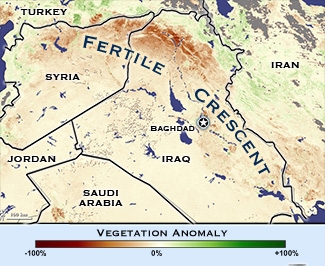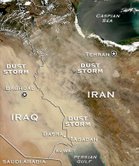The future of agriculture in the "Fertile Crescent" looks bleak due to a combination of climate change and human activity

Every student remembers the concept of the "fertile crescent" which refers to the arc formed by the Euphrates and the Tigris.
The floodplains of the rivers enabled the development of ancient civilizations such as Sumer and Babylon and gave impetus to ideas, stories and religions.
The same area that is also called the "Cradle of Humanity", (together with the Nile) is the area where agriculture, culture and writing began to develop. These are just some of the crowns that were attached to the region that is now controlled by Turkey, Syria, Iran and Iraq.
However, the future of agriculture in the "Fertile Crescent" looks bleak due to a combination of climate change and human activity, an activity that mainly diverts the water up the rivers.
After two years of severe drought, a drought that experts warn may turn into a permanent and permanent climatic condition, the Turks stop most of the river water in dams, which turns the flow in the Tigris into trickles that do not meet the demands of the farmers down the rivers.
To the east, the Persians began building a dam on the sources of the Euphrates, a dam that takes the water from the river and the people living down the Euphrates.
Iraq calls on Turkey (and Syria) to release increasing amounts of water to ease the plight of farmers, but according to the state of things today, the Turks have no intention of pleasing their neighbors, moreover the Turks are engaged in planning another dam on the Tigris.
In the picture above you can see how the vegetation is thinning between the Persian Gulf and northwest to the Mediterranean Sea, a thinning caused by the drought and the lack of flow in the rivers.
The immediate result is an ever-spreading desertification, a desertification that causes dust storms on a scale that was not known in the region, storms that cover vast areas, a desertification that turns the "fertile crescent" into a barren area!

Since I mentioned the Nile at the top of the list, it is worth emphasizing that even along the length of the world's longest river there are problems arising from increasing demands for the use of water by the countries through which the river flows, problems that are not resolved because of Egypt's position, which claims the use of 85% of the water for itself and threatens violence in the event that of the states will be harmed by this (historical) right.
And so it turns out again that we are not alone, the water problem is getting bigger and bigger in our immediate environment and in the whole world.

10 תגובות
Or and Ami:
Both of you are right.
I did a number of Google searches that confirm your words and reveal additional problems.
There are too many links and I haven't gone through them all, but you can find them if you search Google for the combination of the phrases "Desalination plants" and Footprint
Michael,
In addition to the energy cost, desalination plants occupy extensive coastal areas. The coastal ecosystems there will be damaged, as in any case of construction on the beach.
I really don't understand how the governments are not organizing to solve the problems with the help of desalination with solar energy.
A dream is not only Israel. It's probably the whole area...
Michael,
What you say is true regarding energy - but it must be remembered that the desalination products are also waste that must be used wisely. Today, to the best of my knowledge, the salts and organic matter obtained from seawater desalination are buried. The world's population has more or less reached its upper limit in the carrying capacity of the water (at least this is what can be understood from populist publications). If the population continues to grow it means that more water will originate from the sea. In the end, all this chaff (the salt) can be a real problem and we must treat it accordingly and develop technologies that know how to eliminate the hazard that today still does not threaten anything.
scientist:
Water desalination mainly uses energy, so the main effect will be the use of more energy.
What will determine, therefore, in the end, is the source of the energy we will use.
If we reach, for example, a situation where all energy comes from renewable sources (such as sun, wind, sea waves, etc.) desalination will not have any negative effect.
Using gas energy will be less harmful than using oil.
In any case - the main ecological impact will be in the water sector and one of the most important elements (from our point of view) in this projection is that people will be able to continue living here.
Does the desalination of sea water in large quantities (as planned in Israel) have no ecological effects?
The straw man needs to bring down huge companies that exploit and devastate all our natural resources for the sake of money
and switch to green energy and water desalination
Dogmat
There is a problem, but what can be done to prevent a crisis?
There will still be big wars here around the water.
I don't understand the Egyptians - why don't they worry about the future and build desalination plants as they started to build in Israel?
And in general, has research been done on the effect of handling large amounts of water on the Mediterranean Sea?
Good and interesting article. Thanks.